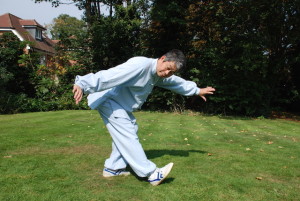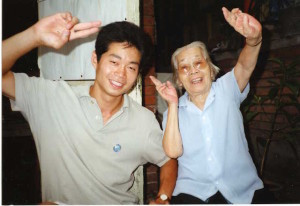About Kunlun Dayan Qigong
Master Michael Tse began his studies in China in 1984 with Grandmaster Yang Meijun who was the 27th generation inheritor of the Kunlun Dayan Qigong skill. Every year he would travel to China to study with her, developing his Qigong and Qigong healing skill. Although Grandmaster Yang Meijun passed away in 2002, she lived to the age of 104 years old and her name is known throughout the world as one of the most famous Qigong masters who lived in this century.
Master Tse always says, “I am so lucky to have met and studied under such a Sifu. Although Sifu is no longer here, her skill is still alive and helping so many people to be healthy and good people. She had a remarkable life and went through many difficult times but she always kept practising her Qigong skill.”
Many of her stories, including how she came to learn the Wild Goose Qigong skill from her grandfather and some of the extraordinary events in her life are related in Wild Goose Qigong book series books by Michael Tse.
Although a very tiny lady, her presence was much larger and she was a very strong person who gave a great gift to the world by opening the Kunlun Dayan skill to the public. For over 1800 years the Kunlun Dayan Qigong skill was practised in secret, until she herself opened the skill in the 1980’s. She did this because she had seen so many people die during the Cultural Revolution and she was afraid that if she passed the skill on to only one person, then the skill might be lost. She made the Wild Goose name famous in China, travelling throughout China and Hong Kong to help promote the Dayan Qigong skill.
Origins of Wild Goose Qigong
Kunlun Shan is a mountain range in Western China, almost on the edges of Tibet and it is here that the Kunlun Dayan Qigong skill was developed during the Jin Dynasty. The skill was developed by Daoist monks who had made this area their home. The monks often observed the wild geese who lived there. Da (Big) Yan (Wild Geese) are considered birds of longevity in China and so they would have been a special animal symbol to a Daoist monk who was cultivating himself to live longer in order that he could achieve immortality. Dayan are also symbols of unity as they always fly together as a flock.
 Wild Goose Qigong (also called Dayan Qigong) began to be developed based upon the movements that the monks observed in these beautiful birds. They also combined the skill with their knowledge of Chinese medicine theory which included knowledge about the channels and acupoints in the body. Wild Goose Qigong is the foundation form of this Qigong system but many other forms followed until eventually there were at least 72 forms and methods. Daoism uses a lot of numbers and each number has a special meaning and connection. Some relate to the Yijing (Book of Changes), some to the stars and constellations in the sky and some to the Bagua. There is more information on this in Michael Tse’s Wild Goose Qigong books.
Wild Goose Qigong (also called Dayan Qigong) began to be developed based upon the movements that the monks observed in these beautiful birds. They also combined the skill with their knowledge of Chinese medicine theory which included knowledge about the channels and acupoints in the body. Wild Goose Qigong is the foundation form of this Qigong system but many other forms followed until eventually there were at least 72 forms and methods. Daoism uses a lot of numbers and each number has a special meaning and connection. Some relate to the Yijing (Book of Changes), some to the stars and constellations in the sky and some to the Bagua. There is more information on this in Michael Tse’s Wild Goose Qigong books.
Not all of the Kunlun Dayan Qigong forms are long forms like the Wild Goose Qigong. Some are shorter forms, like Eight Pulling Waist Gong or Seven Star Opening Gong. Some of the skills are different meditations and some are healing skills. In addition, Master Tse has continued to develop other Qigong forms, such as Balancing Gong and Healthy Living Gong, based upon the principles of the Kunlun Dayan System.
Daoist Connection
 At the time of the Eastern and Western Jin Dynasty (265-420 A.D.) Daoism was also developing. Daoism advocates leading a simple life in harmony with nature. This was also a time of much artistic development, particularly writing, calligraphy and painting. However, it was also a tumultuous time with many wars between countries. With so much of China in upheaval, there came a growing popularity in things of a spiritual nature.
At the time of the Eastern and Western Jin Dynasty (265-420 A.D.) Daoism was also developing. Daoism advocates leading a simple life in harmony with nature. This was also a time of much artistic development, particularly writing, calligraphy and painting. However, it was also a tumultuous time with many wars between countries. With so much of China in upheaval, there came a growing popularity in things of a spiritual nature.
Many Daoist masters went into the mountains to live and develop themselves without the distractions of politics and strife. Some of them joined together and built their own Daoist temples to help them further their studies on how to become one with nature and also develop their skill and pass it down to the next generations. Living in harmony with nature also meant your own internal body should be in balance. Daoists viewed the body as a complete universe in itself and the there is a diagram which shows this.
Buddhist Connection
During the Jin Dynasty, there lived a very famous Buddhist monk called Si Dao An. He was responsible for the translation of many Buddhist texts from their original Sanskrit. He travelled to many different places giving lectures, sharing Buddhist knowledge and building temples. Many thousands of temples were built in China during this time.
Whilst Daoism aims for longevity and balance with nature, Buddhism aims for non-attachment and enlightenment. When we practise Wild Goose Qigong, we first need to relax and empty our minds. When we can empty our minds, then we do not need to think about Qi or where it goes and what it does. Everything happens naturally. This emptiness is also one of the goals of Chan Buddhism because when we can let go of our emotional attachments and worries, then wisdom can then develop. Si Dao An is considered the spiritual founder of Wild Goose Qigong which is related to the Amitabha school of Buddhism.
Rujia (Confucian) Connection
Rujia is the proper name for Confucianism and Kong Zi is the proper name for Confucius. During his lifetime, he promoted the Wu Chang which meant the Five Standards of behaviour for a good human being. Some called it the Five Virtues. These were:- compassion, loyalty, courtesy, wisdom and trust. Of these, loyalty was one of the most important because if a person were loyal, it also meant that they were stable and could build on a good foundation. If a person was always changing from one thing to another or could not keep their word, then none of the other good behaviours could develop.
In the Kunlun Dayan Qigong system, there was a traditional rule was that the skill could only be passed down to one other person but not until the practitioner reached the age of 70. This tested the person’s loyalty to their word and to their practise. If they could do this, then wisdom, compassion, trust and courtesy would naturally follow. If they reached this age, then it also meant they had reached a good skill level and was healthy, thus proving that the Qigong was good.
In Chinese thinking, both spiritual and physical are intertwined and good health is not exclusive to the body. The mind also be considered. Michael Tse says, “When you come to a certain level in your studies, you may feel like you are not progressing. This is because you have gone as far as your physical body can manage. The next is to develop the mind and heart.”
“If you are still stubborn or angry or impatient, this means your internal organs are not healthy enough. So it is not enough just to train the body. We must also train our attitude. One of the ways to train the heart is through meditation. Meditation helps to store our energy but it also helps to calm down the emotions so we can be healthy and balanced.” The philosophies of Daoism and Rujia and particularly Buddhism are all education methods for training the spiritual heart whilst Kunlun Dayan Qigong trains the physical heart.

